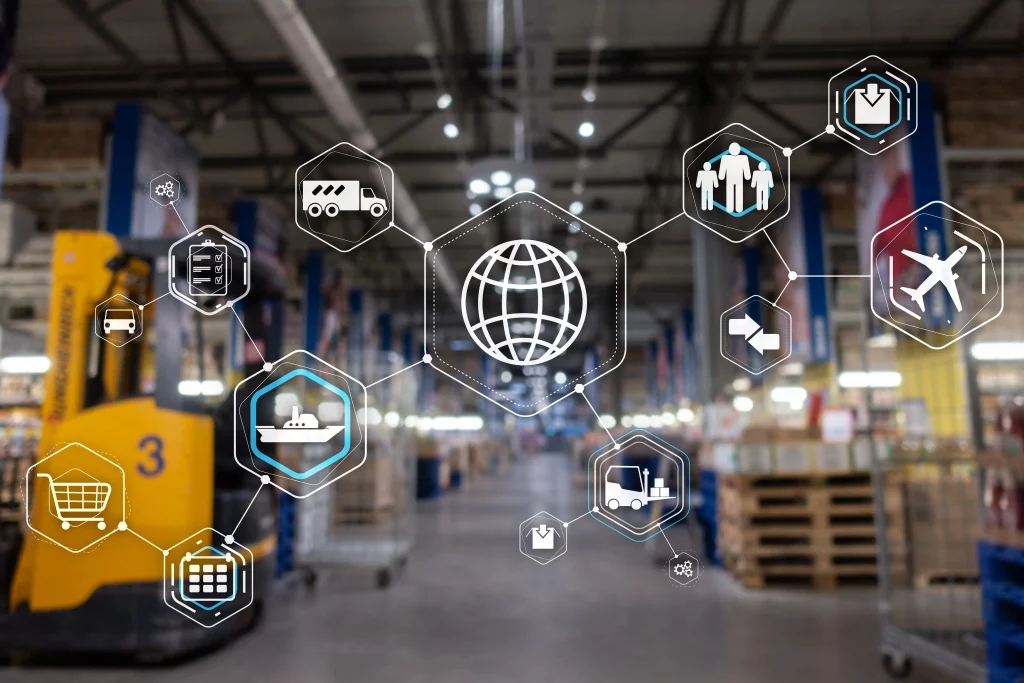Logistics is the lifeblood of e-commerce. Without the efficient and timely movement of goods, online shopping would lose its essence. The rapid innovations in this sector are paramount in ensuring that e-commerce thrives, especially in a booming market like Europe.
As we approach 2024, the transformations we’ve seen in 2023 are indicative of the trajectory of modern logistics. In this guide, we’ll delve into the key innovations and trends that are shaping the future of logistics.

The Digital Transformation of Logistics
If you’re involved in logistics or e-commerce, understanding this digital shift is crucial. Digital tools and processes are now fundamental in streamlining operations and ensuring timely deliveries. Let’s explore the advancements and their implications.
The Rise of Digital Freight Marketplaces
Digital freight marketplaces are platforms that simplify the process of matching shippers with suitable carriers. These platforms are crucial in the modern age as they reduce the friction traditionally associated with freight shipping.
By streamlining the connection process, they facilitate faster, more efficient transactions, ensuring goods reach their destinations promptly.
Here’s what sets them apart:
- Cost-Effective Solutions: With real-time bidding and direct negotiations, shippers can secure competitive rates, while carriers can maximize their load capacity, leading to reduced empty runs.
- Enhanced Visibility: Advanced tracking features mean that shippers can monitor their freight in real-time, leading to better communication with end customers about delivery timings and any potential delays.
- Data-Driven Decisions: These platforms aggregate vast amounts of data, enabling businesses to analyze shipping patterns, identify bottlenecks, and make informed decisions about their logistics strategies.
- Trust and Security: Integrated payment gateways, verified carrier profiles, and user reviews ensure that transactions are secure and both parties are credible.
API-Based Integrations in Logistics
The logistics world is moving from batch processing to real-time processing, all thanks to API-based integrations. These integrations allow e-commerce businesses to sync their operations with logistics providers in real-time. The result? Enhanced efficiency, reduced errors, and a better overall shopping experience for customers.
Here are the key facets of these integrations:
- Seamless Communication: APIs provide a channel for different software systems to communicate effortlessly. For logistics, this means that inventory systems, order processing platforms, and shipping services can work in harmony without manual intervention.
- Dynamic Updates: Real-time data flow ensures that any changes in inventory levels, order statuses, or delivery timings are instantly updated across all platforms. This aids in maintaining accurate stock levels and ensures timely order fulfillment.
- Scalability: As businesses grow, their logistical needs evolve. API-based integrations are inherently scalable, allowing businesses to handle increased order volumes without overhauling their entire logistical setup.
- Data Insights: With data flowing seamlessly between platforms, businesses can harness this information to gain insights. This can help in optimizing routes, predicting demand, and even in devising marketing strategies based on delivery performance.
The Persistence of Digital Transformation
Digital transformation continues to permeate every facet of logistics. With the push for end-to-end automation and the modernization of Electronic Data Interchange (EDI), the industry is witnessing a shift towards event-based workflows. This shift is pivotal in ensuring that logistics processes are more streamlined and responsive.
Here’s a closer look at the implications:
- Faster Decision Making: With real-time data at their fingertips, businesses can make quicker, informed decisions, reducing downtime and improving overall efficiency.
- Enhanced Collaboration: Modern EDI and digital platforms foster better communication between shippers, carriers, and other stakeholders, ensuring everyone is on the same page.
- Error Reduction: Automated processes and digital checks mean fewer manual interventions, leading to a significant decrease in errors and discrepancies.
- Flexibility and Scalability: A digital-first approach allows logistics providers to adapt to changing market dynamics swiftly and scale operations up or down based on demand.
Embracing Automation in Logistics

Automation is reshaping how goods are stored, handled, and transported, making operations more efficient and accurate. In this section, we’ll delve into the key aspects of automation in logistics and what it means for the industry’s future.
Addressing Global Labor Shortages
The logistics sector, like many others, faces significant labor shortages. This challenge, however, is being addressed through the rapid adoption of automation in warehousing and transportation. Automated systems and robots are now handling tasks that were traditionally labor-intensive, ensuring that the industry keeps pace with demand.
- Steps to Automation:
- Assessment: Businesses first identify areas within their logistics operations that are most affected by labor shortages and determine which tasks can be automated.
- Integration: Advanced robotics and automated systems are then integrated into these identified areas. This could involve deploying robotic arms for sorting, automated guided vehicles for transportation, or even drones for delivery.
- Training: While automation reduces the need for human labor in certain areas, it also necessitates training existing staff to manage and maintain these automated systems.
- Continuous Monitoring: Post-integration, businesses continuously monitor the performance of these automated systems to ensure they are operating optimally and making necessary adjustments.
- Benefits of Addressing Labor Shortages Through Automation:
- Consistency and Reliability: Automated systems operate with a high degree of accuracy and consistency, reducing errors.
- Increased Productivity: Automation allows for 24/7 operations, significantly boosting productivity levels.
- Cost Savings: Over time, the initial investment in automation pays off through reduced labor costs and increased efficiency.
- Safety: Robots and automated systems can handle hazardous tasks, reducing workplace accidents and ensuring safer operations.
- Scalability: As demand grows, automated systems can be scaled up more easily compared to human labor, providing flexibility during peak seasons.
Complexity Management through Automation
With the growth of e-commerce, the integration of Warehouse Management Systems (WMS) and Enterprise Resource Planning (ERP) systems with e-commerce platforms is crucial. Automation facilitates this integration, ensuring seamless data flows. For e-commerce businesses, this means reduced errors, faster processing times, and enhanced customer satisfaction.
- Understanding WMS and ERP:
- Warehouse Management Systems (WMS): These systems are primarily concerned with the management of inventory within a warehouse. They handle tasks such as inventory tracking, order picking, and restocking, ensuring that products are stored efficiently and can be retrieved quickly.
- Enterprise Resource Planning (ERP) Systems: ERP systems offer a holistic approach to business processes. They integrate various functions such as finance, human resources, and procurement into a single system, allowing for better data visibility and process optimization.
- The Synergy between WMS, ERP, and E-commerce Platforms:
- Real-time Inventory Updates: As orders are placed on e-commerce platforms, inventory levels in the WMS are updated in real-time. This ensures accurate stock levels and helps in preventing overselling.
- Order Processing: Once an order is received on the e-commerce platform, the WMS facilitates the picking and packing process, while the ERP system handles the financial aspects, such as invoicing and payment processing.
- Supply Chain Visibility: Both WMS and ERP systems offer analytics and reporting tools. When integrated with e-commerce platforms, businesses gain insights into customer preferences, sales trends, and inventory turnover, aiding in better decision-making.
- Benefits of Integration through Automation:
- Unified Data Source: Automation ensures that data flows seamlessly between the systems, creating a unified source of truth. This reduces discrepancies and ensures that all systems are always in sync.
- Improved Forecasting: With integrated data, businesses can better forecast demand, optimize inventory levels, and plan promotions or discounts.
- Enhanced Customer Experience: Real-time data means customers receive accurate information on product availability, shipping times, and order status.
Enhancing Supply Chain Efficiency
Effective supply chain management ensures timely deliveries, reduces costs, and enhances customer satisfaction. In this section, we’ll discuss the strategies and tools that are elevating supply chain efficiency.
The Need for Supply Chain Agility
Nowadays, agility is key. E-commerce businesses need to adapt quickly to market changes. Self-managed services, which allow businesses to manage their supply chains autonomously, are emerging as a solution, enhancing the nimbleness required in modern logistics.
Beyond the evident need for adaptability in e-commerce, several factors highlight the importance of agility in supply chains:
- Dynamic Consumer Preferences: Rapid changes in consumer tastes and expectations.
- External Factors: Geopolitical events, pandemics, and other unpredictable occurrences can impact supply chains.
- Flexible Response: Agile methodologies allow businesses to adapt in real-time to market shifts, ensuring minimal disruptions.
- Maintaining Trust: Quick adaptability ensures consistent service, building and maintaining customer trust.
Demand Forecasting in Logistics
Estimating future customer demand, or demand forecasting, is pivotal in ensuring that e-commerce businesses are well-prepared to meet customer needs. By accurately predicting demand, companies can optimize their operations and resources, ensuring efficiency and cost-effectiveness.
The process of predicting customer demand has multiple facets that underline its significance:
- Advanced Analytics: Utilization of tools and machine learning models for precise demand prediction.
- Past Sales Data: Analyze historical data to gauge future demand.
- Seasonal Trends: Recognize patterns related to seasonal sales spikes or dips.
- Inventory Management: Anticipate warehousing needs based on forecasted demand.
Supply Chain Transparency and Collaboration

Integrating EDI and APIs is enhancing transparency and collaboration in the supply chain. For e-commerce businesses in Europe, this means better inventory management, reduced costs, and the ability to provide customers with real-time updates on their orders.
The merger of EDI and APIs to boost transparency and cooperation in supply chains revolves around several key points:
- Seamless Data Flow: Integration ensures continuous data exchange between different systems.
- Cost Efficiency: Automated data sharing reduces manual errors, leading to cost savings.
- Real-time Updates: Customers receive immediate information about order status, enhancing their shopping experience.
- Strengthened Collaboration: Enhanced communication between suppliers, shippers, and retailers.
Meeting Customer Expectations
Customers today expect faster and more transparent services. In this section, we’ll explore the methods and innovations that businesses are adopting to meet these demands and ensure customer satisfaction.
To meet the evolving demands of today’s customers, businesses are focusing on a few key strategies:
- Digital Platforms: Offering real-time tracking and customer support.
- Feedback Mechanisms: Allowing customers to provide feedback, helping businesses improve.
- Tailored Services: Personalizing shopping experiences based on customer data and preferences.
Real-Time Data and Visibility for Customers
The “Amazon effect” has significantly influenced customer expectations. Shoppers now expect real-time updates on their purchases. Integrating WMS/ERP systems with visibility platforms is key in meeting this expectation, ensuring that customers are always in the know.
To address the rising customer expectation for immediate updates, several core elements are being integrated:
- Integrated Systems: WMS/ERP systems sync with e-commerce platforms for instantaneous data sharing.
- Delivery Tracking: Customers can track their orders in real-time.
- Inventory Levels: Real-time data ensures accurate stock level representation on e-commerce platforms.
Less Than Truckload (LTL) Demand
With the growth of e-commerce, there’s a rising demand for LTL shipping. This shipping method, which caters to smaller freight loads, is especially beneficial for e-commerce businesses in Europe, allowing them to ship goods more cost-effectively and efficiently.
The surge in LTL shipping demand, especially in the realm of e-commerce, can be broken down into the following considerations:
- Cost-Effective: LTL shipping often proves cheaper for businesses shipping smaller loads.
- Flexible Scheduling: Businesses can schedule shipments based on their needs without waiting for a full truckload.
- Reduced Carbon Footprint: Efficient use of cargo space means fewer trips, leading to reduced emissions.
- Rapid Growth in Europe: European e-commerce businesses are increasingly leveraging LTL for its efficiency and cost benefits.
Conclusion
As we move closer to 2024, the evolving trends in the logistics domain are crucial in defining the future of logistics and e-commerce in Europe.
Innovations spanning automation to digital overhauls are elevating operational efficiency, aligning with customer expectations, and solidifying the growth trajectory of the e-commerce industry.
For European enterprises, it’s clear that adopting these trends is not just beneficial—it’s essential.